Unmistakably inspired by 18th century Louis XVI design, Louis Ghost Chair is an inexpensive, stackable and modern piece. More than 2 milions have been sold, according to its manufacturer, Kartell.
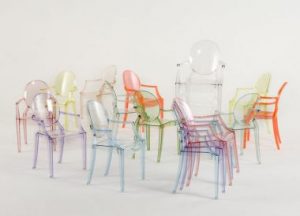
Image source: http://www.moderndesign.org/2009/10/kartell-louis-ghost-chair-by-philippe.html
The Ghost
The chair’s transparency gives off an ethereal, almost ghost-like presence; it is, in other words, conspicuously inconspicuous, a piece of see-through, at the same time enhancing the visibility of its sitting occupant, who, in addition, sees himself discreetly aggradized by the throne -like armrests and medallion back. The Ghost broke tradition, going beyond the 20th century’s diffused notion that plastic was nothing more than cheap and disposable, and yet Starck placed it on a par with wood and metal as a high-end design material.

Image source: https://search.creativecommons.org/photos/436cf82c-d465-4ea8-baca-bd15485b2ae5 by Conference Basics
History
The story of the Louis Ghost Chair, as is its full name, begins with Louis XVI, the XVIII century king of France. During the reign of the 19-year-old monarch and his better half, Marie Antoinette, a renewed interested in classical Greek and Roman designs developed, manifesting itself in all sorts of architectural and interior design trends quickly developing throughout the king’s reign. One such was the furnishing of a chair with a rectangular or round upholstered back, clean lines, column-like carved legs, and an exposed wood frame; in return, this chair style earned the name of the monarch, becoming known as the Louis XVI Chair. This formal upholstered chair remains one of the most popular chair designs to this day, considered a timeless classic.
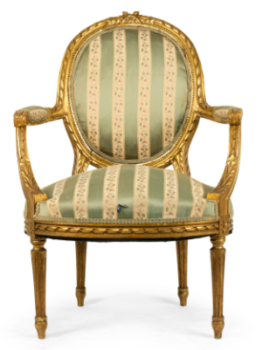
Image source: https://www.newel.com/product/french-louis-xvi-gilt-arm-chair
The Louis XVI chair has seen all manner of redesigns and interpretations, but for the most part, they focused around the upholstery fabric and paint color choice. However, Philippe Starck had something else in mind. In 2002, Starck reinvented the classic Louis XVI armchair for Italian design company Kartell, already known for its innovative use of plastics. The designer distilled the antique furniture piece down into one silhouetted shape, translating its round, medallion-shaped backrest, curved arms, and straight legs into a single, clear plastic chair. Calling upon not only the reign of Louis XVI, but on ancient Greek geometry, the chair was a triumph of postmodern times. As Starck himself said, the chair “has a mix of materials and styles based on our shared memories”.

Image source: https://search.creativecommons.org/photos/11058716-0225-4354-ac22-fa096e04a991 by Wicker Paradise
Kartell, changing perceptions of plastic
Founded nearly 70 years ago in 1949, Milan based design brand Kartell was created by Giulio Castelli and has been a symbol of progressive Italian design ever since. A true story of success, their journey is mapped through a series of incredible products across furniture, furnishings and lighting categories which have not only become a key part of the domestic landscape, but also true icons of contemporary design.
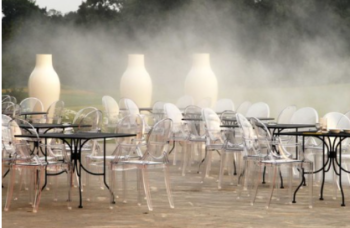
Image source: https://search.creativecommons.org/photos/c70fbf50-2544-4d3b-85c3-b1fa1aafce8d by kartellpeople
From the very beginning of the brand, Kartell have taken an innovative approach toward product development. Their renowned ‘plastics project’ was heavily focused on technological research and design to deal with the material which unlike natural materials lacks a visual identity before production. This lead to the brand being known for their industrial manufacture of designer items crafted from top quality, high-tech plastics. Through utilising cutting edge technologies, innovative thermoplastics and managers themselves involved in the making of each product, Kartell are able to guarantee their DNA is found in the technology, quality, resistance and durability of every piece. A key turning point for Kartell came in 1999, when after years of research a revolutionary innovation led to then becoming the first company in the world to use polycarbonate to produce furniture.
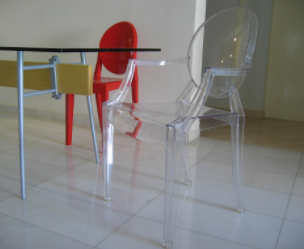
Image source: https://en.wikipedia.org/wiki/Philippe_Starck#/media/File:Table_&_Chairs_by_Philippe_Starck.jpg
Like several other iconic chairs, including the Eames fiberglass armchair, the Louis Ghost owes a lot of its resonance to its engineering. Kartell created it from polycarbonate plastic but, unlike other molded chairs, the Louis Ghost is exceptional because the plastic is injected into a single mold, meaning that the entire piece is made in one fell swoop.
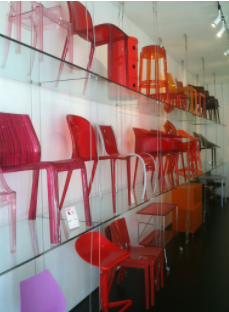
Image source: https://search.creativecommons.org/photos/b9a3dcc9-fd7e-4334-bed6-be9bfb170083 by miamism
Designer
Born in 1949, Paris, Philippe Starck, kick-started his career by designing a pair of nightclub interiors in Paris in the 1970s, a time when using Lucite (clear plastic) as a material for furniture and décor was all the rage. He has since become one of the world’s most acclaimed designers, known for his subversive and cheeky approach to design. From transparent furniture to sculptural lemon squeezers, his designs have changed the way we live with their stylised, organic look often constructed using unusual and innovative combinations of materials.

Image source: https://search.creativecommons.org/photos/d1718b45-ff01-4a2a-8a7d-2fa760e8a5c5 by jikatu
Data Sheet
Designer: Philippe Starck
Year: 2002
Manufacturer: Kartell
Materials: Transparent or batch-dyed polycarbonate
Dimensions:
- Width: 21.1 ”
- Depth: 21.5 ”
- Height: 36.7 ”
- Seat height: 18.3 ”
- Unit weight: 4.8 kg
Info sources:
http://www.kartell.com/gb/small-armchair_cod20000112el.html
https://www.ft.com/content/4ff06b04-f10e-11e5-9f20-c3a047354386
https://www.decaso.com/blog/ghost-chair-history/
